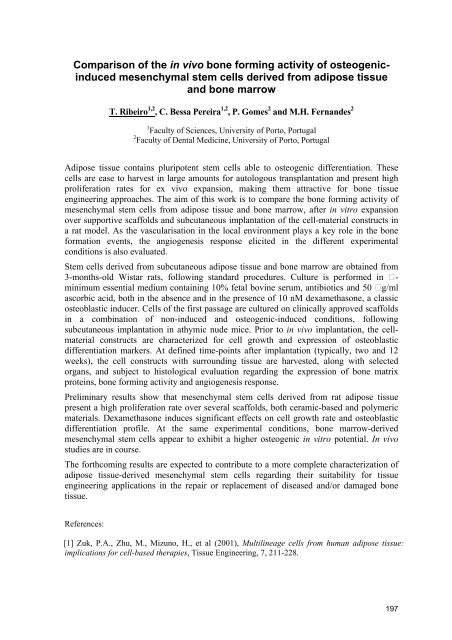IJUP08 - Universidade do Porto
IJUP08 - Universidade do Porto
IJUP08 - Universidade do Porto
- TAGS
- universidade
- porto
- ijup.up.pt
Create successful ePaper yourself
Turn your PDF publications into a flip-book with our unique Google optimized e-Paper software.
Comparison of the in vivo bone forming activity of osteogenicinduced<br />
mesenchymal stem cells derived from adipose tissue<br />
and bone marrow<br />
T. Ribeiro 1,2 , C. Bessa Pereira 1,2 , P. Gomes 2 and M.H. Fernandes 2<br />
1 Faculty of Sciences, University of <strong>Porto</strong>, Portugal<br />
2 Faculty of Dental Medicine, University of <strong>Porto</strong>, Portugal<br />
Adipose tissue contains pluripotent stem cells able to osteogenic differentiation. These<br />
cells are ease to harvest in large amounts for autologous transplantation and present high<br />
proliferation rates for ex vivo expansion, making them attractive for bone tissue<br />
engineering approaches. The aim of this work is to compare the bone forming activity of<br />
mesenchymal stem cells from adipose tissue and bone marrow, after in vitro expansion<br />
over supportive scaffolds and subcutaneous implantation of the cell-material constructs in<br />
a rat model. As the vascularisation in the local environment plays a key role in the bone<br />
formation events, the angiogenesis response elicited in the different experimental<br />
conditions is also evaluated.<br />
Stem cells derived from subcutaneous adipose tissue and bone marrow are obtained from<br />
3-months-old Wistar rats, following standard procedures. Culture is performed in -<br />
minimum essential medium containing 10% fetal bovine serum, antibiotics and 50 g/ml<br />
ascorbic acid, both in the absence and in the presence of 10 nM dexamethasone, a classic<br />
osteoblastic inducer. Cells of the first passage are cultured on clinically approved scaffolds<br />
in a combination of non-induced and osteogenic-induced conditions, following<br />
subcutaneous implantation in athymic nude mice. Prior to in vivo implantation, the cellmaterial<br />
constructs are characterized for cell growth and expression of osteoblastic<br />
differentiation markers. At defined time-points after implantation (typically, two and 12<br />
weeks), the cell constructs with surrounding tissue are harvested, along with selected<br />
organs, and subject to histological evaluation regarding the expression of bone matrix<br />
proteins, bone forming activity and angiogenesis response.<br />
Preliminary results show that mesenchymal stem cells derived from rat adipose tissue<br />
present a high proliferation rate over several scaffolds, both ceramic-based and polymeric<br />
materials. Dexamethasone induces significant effects on cell growth rate and osteoblastic<br />
differentiation profile. At the same experimental conditions, bone marrow-derived<br />
mesenchymal stem cells appear to exhibit a higher osteogenic in vitro potential. In vivo<br />
studies are in course.<br />
The forthcoming results are expected to contribute to a more complete characterization of<br />
adipose tissue-derived mesenchymal stem cells regarding their suitability for tissue<br />
engineering applications in the repair or replacement of diseased and/or damaged bone<br />
tissue.<br />
References:<br />
[1] Zuk, P.A., Zhu, M., Mizuno, H., et al (2001), Multilineage cells from human adipose tissue:<br />
implications for cell-based therapies, Tissue Engineering, 7, 211-228.<br />
197










